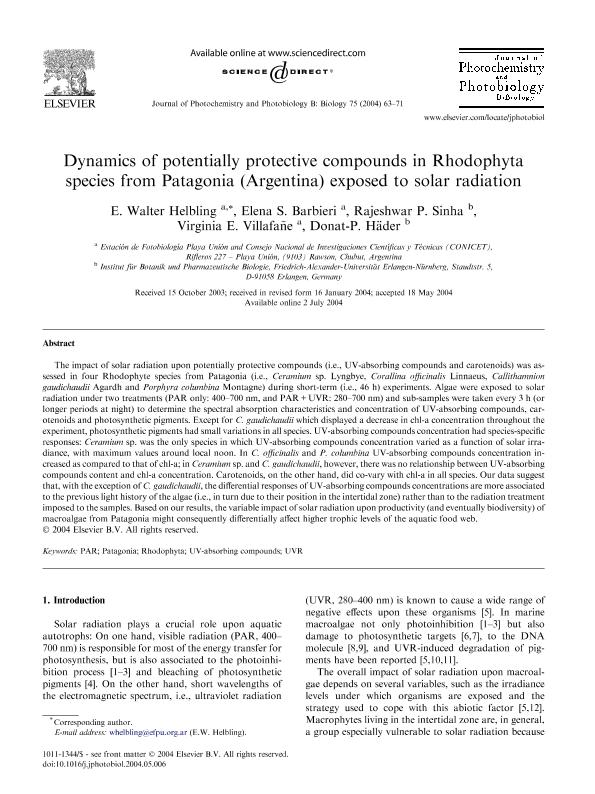Artículo
Dynamics of potentially protective compounds in Rhodophyta species from Patagonia (Argentina) exposed to solar radiation
Helbling, Eduardo Walter ; Barbieri, Elena Susana
; Barbieri, Elena Susana ; Sinha, Rajeshwar P.; Villafañe, Virginia Estela
; Sinha, Rajeshwar P.; Villafañe, Virginia Estela ; Häder, Donat P.
; Häder, Donat P.
 ; Barbieri, Elena Susana
; Barbieri, Elena Susana ; Sinha, Rajeshwar P.; Villafañe, Virginia Estela
; Sinha, Rajeshwar P.; Villafañe, Virginia Estela ; Häder, Donat P.
; Häder, Donat P.
Fecha de publicación:
07/2004
Editorial:
Elsevier Science Sa
Revista:
Journal of Photochemistry and Photobiology B: Biology
ISSN:
1011-1344
Idioma:
Inglés
Tipo de recurso:
Artículo publicado
Clasificación temática:
Resumen
The impact of solar radiation upon potentially protective compounds (i.e., UV-absorbing compounds and carotenoids) was assessed in four Rhodophyte species from Patagonia (i.e., Ceramium sp. Lyngbye, Corallina officinalis Linnaeus, Callithamnion gaudichaudii Agardh and Porphyra columbina Montagne) during short-term (i.e., 46 h) experiments. Algae were exposed to solar radiation under two treatments (PAR only: 400–700 nm, and PAR + UVR: 280–700 nm) and sub-samples were taken every 3 h (or longer periods at night) to determine the spectral absorption characteristics and concentration of UV-absorbing compounds, carotenoids and photosynthetic pigments. Except for C. gaudichaudii which displayed a decrease in chl-a concentration throughout the experiment, photosynthetic pigments had small variations in all species. UV-absorbing compounds concentration had species-specific responses: Ceramium sp. was the only species in which UV-absorbing compounds concentration varied as a function of solar irradiance, with maximum values around local noon. In C. officinalis and P. columbina UV-absorbing compounds concentration increased as compared to that of chl-a; in Ceramium sp. and C. gaudichaudii, however, there was no relationship between UV-absorbing compounds content and chl-a concentration. Carotenoids, on the other hand, did co-vary with chl-a in all species. Our data suggest that, with the exception of C. gaudichaudii, the differential responses of UV-absorbing compounds concentrations are more associated to the previous light history of the algae (i.e., in turn due to their position in the intertidal zone) rather than to the radiation treatment imposed to the samples. Based on our results, the variable impact of solar radiation upon productivity (and eventually biodiversity) of macroalgae from Patagonia might consequently differentially affect higher trophic levels of the aquatic food web.
Palabras clave:
Protective compounds
,
Rodophyta
,
Solar radiation
,
Patagonia
Archivos asociados
Licencia
Identificadores
Colecciones
Articulos(SEDE CENTRAL)
Articulos de SEDE CENTRAL
Articulos de SEDE CENTRAL
Citación
Helbling, Eduardo Walter; Barbieri, Elena Susana; Sinha, Rajeshwar P.; Villafañe, Virginia Estela; Häder, Donat P.; Dynamics of potentially protective compounds in Rhodophyta species from Patagonia (Argentina) exposed to solar radiation; Elsevier Science Sa; Journal of Photochemistry and Photobiology B: Biology; 75; 1-2; 7-2004; 63-71
Compartir
Altmétricas



